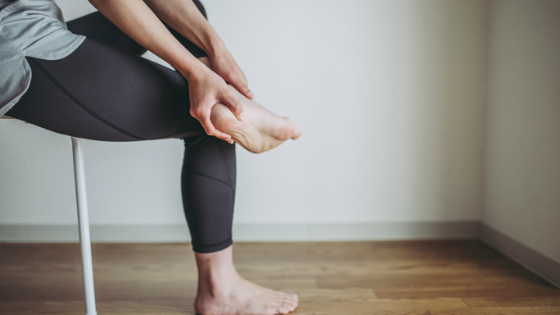
So, did you decide to take up, or increase your walking or running with the pandemic? Both running and walking are excellent ways to keep yourself moving, especially while some activities you normally participate in may have been closed, postponed or cancelled. All you need is a good pair of sneakers or shoes, and off you go! If you increase your activity too quickly, your risk for plantar fasciitis is increased.
Plantar fasciitis is a common cause of foot pain and is a pain in the plantar (bottom of the foot), typically along the medial aspect of the calcaneus (heel bone) that is worse first thing in the morning and then with prolonged weight-bearing. The process of plantar fasciitis is thought to be degenerative in nature and related to overuse and limited ankle motion. The limited motion is dorsiflexion (bringing the toes up towards, the opposite of pointing the toes).
This condition is more common in the age group of 40-60 years old and can be related to shoes without proper arch support. I would suggest resisting the urge to go for that long walk in your flip flops! It is always better to avoid or prevent an injury or condition if possible. If you do run or walk for fitness, increase your distance by no more than 10% each week. This is a good rule to abide by to avoid overuse injuries. Even if you are training for a certain distance run or walk (5K, 10 K, half, or full marathon), increasing by 10% a week is a way to allow your body the time to recover from activity.
If you find yourself with the diagnosis of plantar fasciitis, there are many things you can do.
If you have approval by your primary care provider, non-steroidal anti-inflammatory medication may be helpful for you. A towel stretch pulling your toes back with ankle dorsiflexion for 3-5 minutes before exiting the bed each morning will be helpful. This helps to passively stretch the Achilles tendon and calf muscles (the gastrocnemius and soleus muscles). Ice massage is another way to help with the discomfort and inflammation.
One of the easiest ways to do this it to freeze water in small paper cups and tear off the top of the cup to expose the ice. Slowly returning to activity is recommended, slow and progressive distances and time on the feet. Sometimes, heel cups (usually made of silicone) are helpful to cushion and provide support.
Stay active with bicycling, swimming, other upper body activities if you develop plantar fasciitis.
Excess weight is also associated with the condition. There is usually some activity that is safe and can keep you “in the game” while healing (pun intended).
See Karen Myrick, DNP, APRN, FNP-BC, ANP-BC speak in 2020 at a Skin, Bones, Hearts & Private Parts event in Destin • San Antonio • Orlando.
